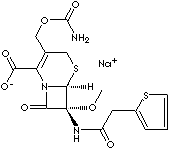PRODUCT IDENTIFICATION
33564-30-6 (Sodium)

H.S. CODE
TOXICITY
CLASSIFICATION
PHYSICAL AND CHEMICAL PROPERTIES
AUTOIGNITION
NFPA RATINGS
REFRACTIVE INDEX
GENERAL DESCRIPTION & APPLICATIONS
Cephalosporin: any of a group of broad-spectrum derived from species of fungi of the genus Cephalosporium and are related to the penicillins in both structure and mode of action but relatively penicillinase-resistant antibiotics. These antibiotics have low toxicity for the host, considering their broad antibacterial spectrum. They have the active nucleus of beta-lactam ring which results in a variety of antibacterial and pharmacologic characteristics when modified mainly by substitution at 3 and 7 positions. Their antibacterial activities result from the inhibition of mucopeptide synthesis in the cell wall. They are widely used to treat gonorrhea, meningitis, pneumococcal, staphylococcal and streptococcal infections. The cephalosporin class of antibiotics is usually divided into generations by their antimicrobial properties. Three generations of cephalosporins are recognized and the fourth has been grouped. Each newer generation of cephalosporins has broader range of activity against gram-negative organisms but a narrower range of activity against gram-positive organisms than the preceding generation. The newer agents have much longer half-lives resulting in the decrease of dosing frequency. Accordingly, the third-generation cephalosporins can penetrate into tissues well, and thus antibiotic levels are good in various body fluids.
APPEARANCE
IDENTIFICATION
Complies Test A,B
ASSAY
pH
IMPURITY
0.5% max (individual), 2.0% max (sum)
5kgs - 20kgs